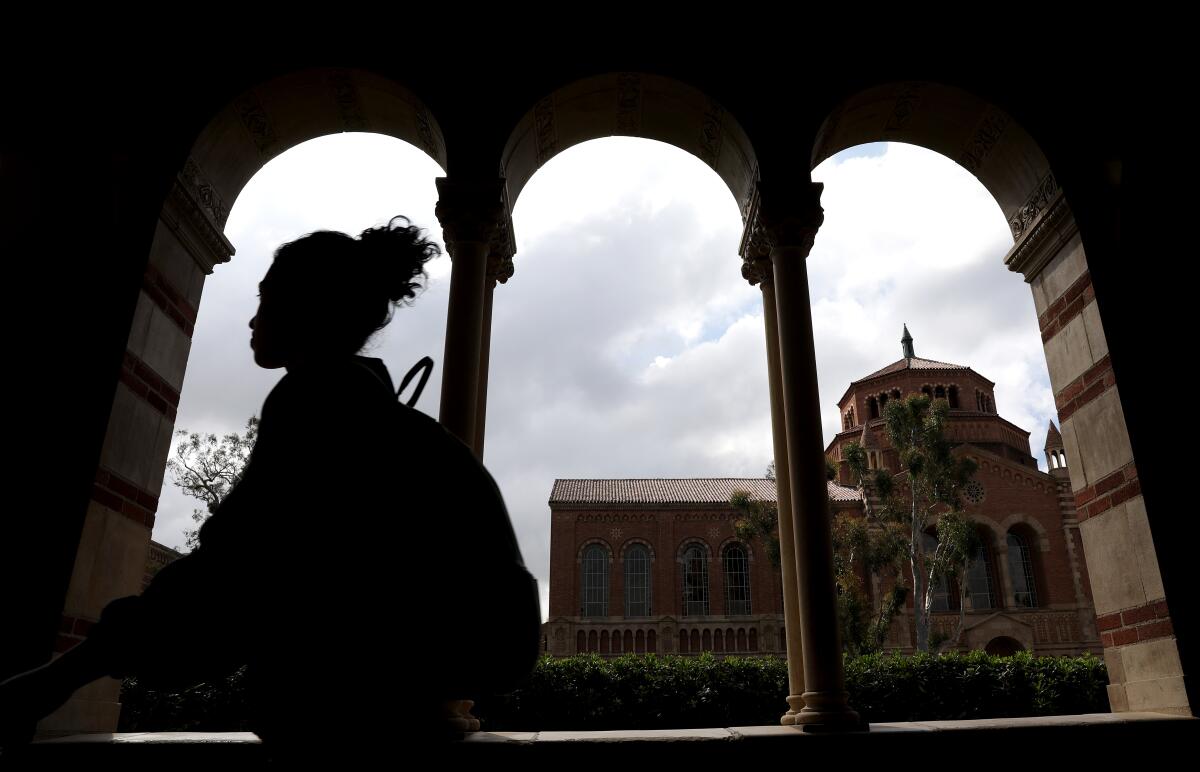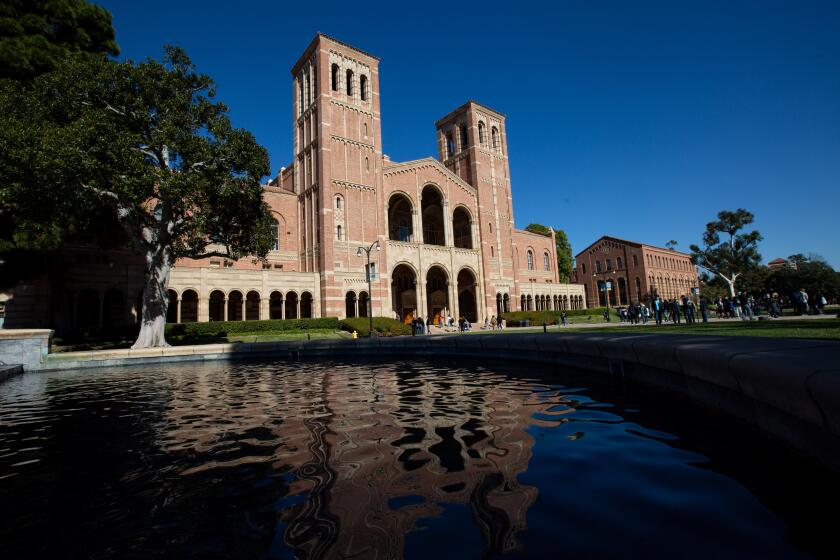UC admits largest, most diverse class ever, but it was harder to get accepted

- Share via
The University of California admitted its largest, most diverse undergraduate class ever for fall 2021 — but it was harder to get in as a record-shattering number of applicants vied for access to the renowned public research system, according to UC data released Monday.
The UC system’s nine undergraduate campuses collectively admitted 132,353 prospective freshmen — including out-of-state and international students — an increase of 11% over last year. Among California applicants, Latinos were the largest group admitted for the second year in a row, making up 37% of the 84,223 students offered freshman seats. Asian Americans made up 34%, white students 20% and Black students 5%. The rest were American Indians, Pacific Islanders or those who declined to state their race or ethnicity.
About 45% of prospective freshmen admitted were low-income while 45% were the first in their families to attend a four-year university. The campuses also admitted 28,453 transfer students from the California Community College system, the largest class ever.
“These remarkable numbers are a testament to the hard work and resiliency of students and their families across California,” UC President Michael V. Drake said in a statement. “I am particularly heartened by the social and economic diversity of those offered a place at UC. Fall will be an exciting time on our campuses.”
The coveted admission offers came in a year of unprecedented changes triggered by the pandemic and UC efforts to ensure more equitable access. UC eliminated the use of SAT and ACT test scores in admissions decisions and made other changes, such as suspending the letter-grade requirements for most of the last two academic years. Such changes helped boost the number of applications for freshman seats this fall to record levels — 203,700, an 18% increase over last year.
Those conditions played out in myriad ways. Admission rates fell at seven of the nine campuses — they rose at UC Davis and UC Merced — with UCLA again setting the highest bar for entry as the most applied-to university in the nation.
Remarkable application surges among Black, Latino and other underrepresented students put the system within reach of dismantling long-standing admission barriers.
UCLA’s admission rate dropped to 10.7% this year from 14.4% last year as applications skyrocketed to 139,463 and students were more accomplished than ever. The average achievement of UCLA’s admitted California freshmen rose to a 4.5 grade-point average. Taking into account semester, quarter or trimester high school terms, students accepted to UCLA completed very rigorous high school curricula with an average 52 terms of college-prep courses. That included an average 23 terms of higher-level courses, such as Advanced Placement. Both are well above minimum requirements for UC eligibility.
“This is the strongest class academically that we have seen in our history,” said Youlonda Copeland-Morgan, UCLA vice provost of enrollment management.
She added that UCLA “overwhelmingly” found that the elimination of standardized test scores had little if any impact on the ability to assess students, since readiness for UC rigor could be gleaned from their high school transcripts’ grades and course work, along with class rank. Other prized values, such as grit, creativity and leadership, came across in essays and activities — validating UC’s 13-factor comprehensive review system, she said.
“Those...factors are sufficient to make a decision,” Copeland-Morgan said, “and I hope this is a new wave of the future for lots of institutions.”
Khadijat Solebo, who graduated last month from Washington Prep High School, is one of the 8,369 California high school students offered a seat at UCLA this fall. Her 4.1 GPA and six honors and Advanced Placement courses may be lower than the Westwood campus average, but UC admissions staff evaluate applicants in the context of their environments and Solebo stood out at her South Los Angeles high school.
She ranked second in her class as the salutatorian. Although Solebo emigrated from Nigeria just four years ago, she plunged into school and community life — serving as junior and senior class presidents, playing varsity soccer and softball and volunteering with the Brotherhood Crusade on water conservation projects.
She said she fell in love with UCLA the moment she stepped on campus three years ago to attend a weekend AP readiness course. “It’s one of the best schools in the world,” said Solebo, who plans to major in biochemistry and become a physician. “I love everything about it.”
Admission offers increased at all campuses except UCLA and UC Santa Barbara. Copeland-Morgan said a greater share of students are accepting UCLA offers so the campus does not need to make as many to ensure all seats are filled. But the freshman class will be somewhat smaller this year, she said, adding that final numbers are still in flux.
UC Santa Cruz also raised its acceptance bar, with 56.5% of admitted freshman applicants earning GPAs of 4.0 or higher compared with 48.5% last year. The admission rate declined to 58.9% from 65.2% last year as the campus received a record 61,708 applications for the fall term.
The higher admission rates at most campuses last year were due in large part to pandemic uncertainty over how many continuing students would return and new ones enroll, admission experts said. And although it was generally harder to get into UC this year compared to 2020, in pre-pandemic 2019 acceptances were even more difficult to achieve, with lower admission rates at six campuses.
“This year more than ever broke our hearts to have to deny so many students given that demand because it’s not as if they can’t be successful here,” said Michelle Whittingham, UC Santa Cruz’s associate vice chancellor of enrollment management. “There’s just limited capacity. And so when there are so many incredible students who aren’t getting an offer, that’s not easy on anyone.”
Reflecting campus efforts to better represent California’s diversity, more admitted students were members of historically underrepresented groups.
At UCLA, for instance, 34% of California incoming freshmen were Black, Latino, American Indian and Pacific Islander students — the largest proportion of such groups in three decades. Black students made up 7% of admitted freshmen, a share matched only by Merced among UC campuses and one that has doubled over the last decade. Copeland-Morgan’s team has aggressively built a pipeline of top recruits by deepening relationships with Black churches, community organizations and a network of L.A. Unified schools to start college prep as early as middle school.
“I’m over the moon,” Copeland-Morgan said. “The years of hard work...bore fruit for us and it’s a good feeling.”
At UC Berkeley, the admission rate dropped to 14% from 17% last year as freshman applications soared to a record 112,820. The campus admitted slightly more California prospective freshmen from underrepresented groups over last year, when it made dramatic progress in diversity with a 36.4% increase in admission offers to them. Outreach efforts have included a “Berkeley En Español” website and a new recruiter for Native American students as part of a reorganized diversity team.
Admissions staff also sought to expand geographical diversity by stepping up virtual campus tours, presentations and events and admitted students from 53 of 58 California counties, along with 54 states and U.S. territories and 102 countries.
“We were clear in our mission to find excellence all across the state,” said Olufemi Ogundele, associate vice chancellor of enrollment management who has spearheaded many of the changes since joining Berkeley two years ago from Stanford University.
UC Irvine made the largest year-to-year gains in diversity, increasing the share of underrepresented students to 41% of Californians offered freshman seats from 29% last year. Among them, the share of Black students doubled and American Indian students tripled. Admission offers to Latino students increased by 30% while those to Asian Americans fell by 25% and to whites by 9.4%.
Asian Americans remained the largest group admitted at each of the campuses except UC Merced because greater numbers of them apply to more campuses and a higher share is accepted when compared with Latinos. When an Asian American student’s multiple applications are considered, 67,715 were accepted systemwide, compared with 60,061 Latinos. But when it comes to individual students, UC admitted 31,220 Latinos and 28,402 Asian Americans.
UC’s admission data, which are preliminary and subject to change, suggest that more students may be putting the COVID-19 pandemic behind them. Several campuses reported that fewer students this year than last are canceling their acceptances and appear poised to begin the fall term.
“I think students literally are really anxious to get started,” Whittingham said.
More to Read
Sign up for Essential California
The most important California stories and recommendations in your inbox every morning.
You may occasionally receive promotional content from the Los Angeles Times.












